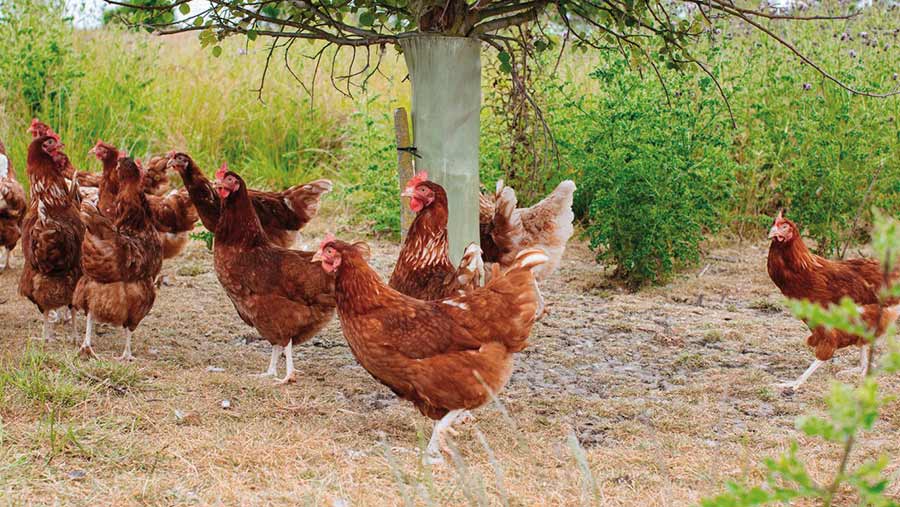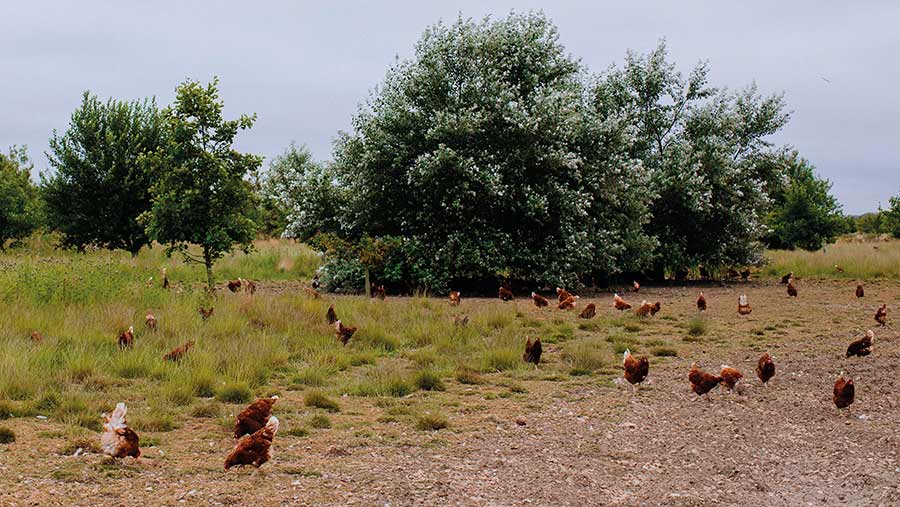How and why two farmers planted trees for crops and poultry
 © LJ Fairburn & Son
© LJ Fairburn & Son Agroforestry is estimated to be practised on 3% of the UK’s farmed land, but at 10% the Woodland Trust says it could help the nation hit climate change targets.
In one example of the practice – shelterbelts – trees are planted to alter the speed and direction of wind, providing shelter for livestock and crops.
See also: £9m fund available to advise farmers during BPS phase out
Research by Harper Adams University shows they improve livestock health, welfare and performance, alongside benefits including increased crop yields, improved water efficiency and higher insect and pollinator numbers.
Shelter and shade for poultry

© LJ Fairburn & Son
Planting shelterbelts has helped L J Fairburn & Son, Lincolnshire, improve the health and welfare of ranging hens and facilitated a premium price for their eggs.
The business is the second-largest egg producer and packer in the UK, with 90 units across 23 owned farms – home to 5 million laying and rearing hens.
It produces colony, barn, organic, free range, and woodland eggs for major UK supermarkets and wholesalers.
The introduction of shelterbelts resulted from a combination of observing bird behaviour and a commercial opportunity. “The bird is a jungle fowl and wants to feed off the ground and perch in trees for protection from predators,” explains welfare manager Bob Waller.
“On the smaller organic units, producers were seeing that the birds were attracted to the hedgerows, using them when moving away from the house. The birds always want to feel close to cover and safety from both overhead and ground predators.”
The business then became aware of the woodland eggs concept, from free-range hens on wooded pasture, sold through Sainsbury’s in partnership with the Woodland Trust.

Bob Waller © LJ Fairburn & Son
Planting
So about 10 years ago it began planting shelterbelts with a mix of native species in blocks across the organic ranges.
“We planted around 7,000 trees in total; the blocks are scattered across the acreage and each contains 30-50 trees covering roughly 30-40m,” explains Mr Waller.
Species include silver birch, elder, oak and beech, with berry-bearing trees in the furthest parts of the range to keep any wild birds away from the house.
At present 80% of the business’s free-range farms have been planted to create woodland in the ranges. Each farm has at least 20% woodland coverage, with 10% being well established.
“We are about to embark on planting up three more units – so between 10,000 and 15,000 trees will be planted in total this year,” he says.
The woodland environment improves bird welfare. “It allows them to behave more naturally, which reduces stress.
Trees provide cover, which make birds feel safe, while their scratching is more diverse,” he adds. “We have also seen less aggression because they can make space for themselves.”
Health benefits
Having birds ranging away from the house has health benefits. “Disease and mortality risk are significantly reduced by not having the birds congregating and producing waste in the immediate area outside the house,” says Mr Waller.
“The trees also provide the birds with shelter from the weather – heat stress can have a big impact on feed intakes, performance and welfare – so the shading helps.”
There are some challenges. “We do of course get levels of predation and outside eggs – but these are manageable and the flocks’ performance is not negatively affected, so the benefits outweigh the challenges.”
The shelterbelts have allowed the business to sell premium woodland eggs. The benefits are circular, with Sainsbury’s donating 1p to the Woodland Trust for every 12 eggs sold.
Lessons learned at L J Fairburn & Son
“The first 50m of ranging can be quite barren, so we’re looking at planting something quick establishing for winter cover – but we don’t want to compromise biosecurity,” explains Mr Waller.
“And our contractual obligations are important; the environment is a big focus so we see planting as a way of meeting them in the future.”
Mr Waller suggest that other farmers looking to integrate trees should be aware that the saplings need to be looked after and protected for the first three to four years.
“Use tree protection and don’t graze stock. In drier spells you need to water them – we used a 10,000 litre water tanker to water each set of trees, but not necessarily 10,000 litres of water every time.”
Funding
The Fairburn planting was funded through the Woodland Trust’s popular Trees for your Farm scheme, funded by Sainsbury’s and the Woodland Trust’s PUR Project.
It offers free site visits, one-to-one advice on how trees can work for your farm business, a planting assessment for the whole farm and tailored planting schemes.
There is a minimum of 500 trees – advisers will help choose the best species for the land and the correct protection for the trees.
Up to 100% funding is available to eligible schemes, with applications being accepted for planting between November 2022 and March 2023.
Silvoarable brings multiple benefits
Silvoarable – the practice of integrating trees with cropping – is helping organic mixed farmer John Pawsey realise an ambition to enhance farm biodiversity and diversify income streams at Shimpling Park Farm, Bury St Edmunds, Suffolk.
He farms 1,630ha, comprising 650ha at home and 980ha of contract farmed land.
The arable business produces wheat, barley and beans, as well as oats, quinoa and spelt for premium markets. The farm also runs 1,000 New Zealand Romney sheep, which are sold locally or through an organic co-operative.
The farm includes Alpheton Wood, a site of special scientific interest (SSSI) ancient woodland, and traditional restorative coppicing produces wood for chipping, as well as timber for premium markets.
Purpose

John Pawsey © Jason Bye
Agroforestry pioneer Martin Wolfe is Mr Pawsey’s inspiration. “I could see the huge benefits to be gained from enhanced farm biodiversity, and from creating a perennial income alongside the annual crop,” he says.
“But you start to think about what could go wrong rather than what could go right. It was when Martin died that I thought I just needed to get on with it.”
So in 2020 Mr Pawsey enlisted the help of agroecological graduate Sam Morgan to develop the agroforestry project.
His primary objectives with silvoarable were to maintain high levels of productivity, secure long-term commercial and environmental gains, and create more diversification and amenity opportunities.
Using species already found on the farm would suit the farm’s soil types and offer the right habitat to attract local insects and wildlife.
The planting would also mimic the SSSI woodland and create vital wildlife corridors by connecting woodland with the wider farming environment.
Planting

Shimpling Park Farm © John Pawsey
Mr Pawsey had to consider cropping and tree alley width to maintain efficiencies and productivity on his 9m controlled traffic system. “We decided on 36m-wide cropping spaces with 4.5m-wide tree allies and no planting on the headlands,” he says.
Over the winter he planted 3,500 trees in three fields covering 20ha. These went in at the latter end of a two-year grass ley and the first arable crop grown alongside will be spelt, drilled this autumn.
The trees were planted as 30cm whips in 1.5m tubular tree guards. “Whips catch up quickly, often growing out the top of their guards by the end of the season.
“Larger saplings are more expensive and prone to planting shock, which increases the cost if you’re having to replace losses,” he adds.
Fifteen native tree species were planted, including oak, cherry, hornbeam, aspen, field maple, wild service, and goat willow, with the main driver being to enhance farm biodiversity.
Benefits
“We have 20 years of biodiversity data as a benchmark, so we will be able to assess the effect of the agroforestry as it matures,” says Mr Pawsey.
“Trees have potential to improve crops by benefiting water efficiency, soil health and stability, carbon sequestration and protection from weather,” he adds.
“Concerns around crop shading and drainage can be managed by eye and by maintaining field ditches.”
Lesser reliance on the SSSI woodland will secure future timber resources and preserve habitat, with hazel planted alongside premium timber as protective nurse trees and coppiced on a 10-15 year cycle for woodchip.
The diverse mix of species and coppicing will avoid a clear fell system. “We’re aiming for a living resource for the future,” says Mr Pawsey.
The goat willow will eventually provide sheep with browsing material and shelter, with studies showing encouraging liveweight gains in agroforestry systems.
Advice
Mr Pawsey rates the Woodland Trust’s advice and grant funding. “With the advice we had we were confident the spending was necessary; but the funding did make a difference.”
For anyone looking to integrate trees, it’s important to know your long-term objectives, he says. “This will make decision-making and planning much easier. And just get on with it as soon as possible.”
Thanks to Woodland Trust, whose sponsorship made it possible for us to run this article. Farmers Weekly had full editorial control of its content.
Woodland Trust MOREwoods scheme

Trees should be in every farmer’s toolbox. They boost productivity, resilience and the health of the environment – with no need to trade off with production. Make your planting project a success with the Woodland Trust’s MOREwoods scheme, funded by Lloyds Bank.
Plant at least 0.5ha and we could cover up to 75% of costs. An expert will visit to discuss the best options for your business and if eligible, arrange tree delivery and protection.
All trees are sourced and grown in the UK and Ireland. No obligation advice is available even if you decide not to plant.
